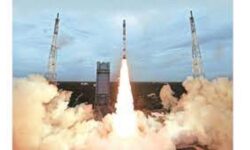
WASHINGTON:
NASA has selected a new Earth science mission that will study the behaviour of tropical storms and thunderstorms, including their impacts on weather and climate models.
The mission will be a collection of three SmallSats, flying in tight coordination, called Investigation of Convective Updrafts (INCUS), and is expected to launch in 2027 as part of NASA’s Earth Venture Programme, the US space agency said in a statement.
NASA selected INCUS through the agency’s Earth Venture Mission-3 (EVM-3) solicitation that sought complete, space-based investigations to address important science questions and produce data of societal relevance within the Earth science field. NASA received 12 proposals for EVM-3 missions in March 2021. After detailed review by panels of scientists and engineers, the agency selected INCUS to continue into development.
“Every one of our Earth science missions is carefully chosen to add to a robust portfolio of research about the planet we live on,” said Thomas Zurbuchen, associate administrator for the agency’s Science Mission Directorate in Washington, in a statement.
“INCUS fills an important niche to help us understand extreme weather and its impact on climate models — all of which serves to provide crucial information needed to mitigate weather and climate effects on our communities,” he added.
INCUS aims to directly address why convective storms, heavy precipitation, and clouds occur exactly when and where they form. Climate change is increasing the heat in the oceans and making it more likely that storms will intensify more often and more quickly, a phenomenon NASA scientists continue to study.
Storms begin with rapidly rising water vapour and air that create towering clouds primed to produce rain, hail, and lighting. The greater the mass of water vapour and air that is transported upward in the atmosphere, the higher the risk of extreme weather.
This vertical transport of air and water vapour, known as convective mass flux (CMF), remains one of the great unknowns in weather and climate. Systematic CMF measurements over the full range of conditions would improve the representation of storm intensity and constrain high cloud feedbacks — which can add uncertainty — in weather and climate models.
NASA’s Earth Venture Programme consists of science-driven, competitively selected, low-cost missions/investigations. This programme provides opportunities for investment in innovative science to enhance our capability to better understand the current state of the Earth system and further improve predictions of future changes.




